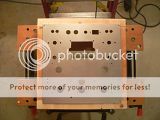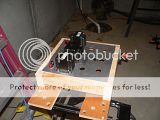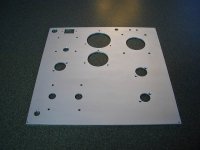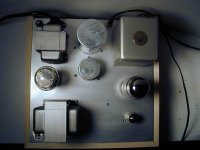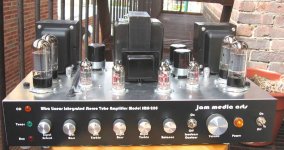While I've used many chassis just like this made by Bud and Premier, but never the Hammond brand, it should work well. It helps to keep the transformers near the corners or edges for better support. If you should find that the top wants to sag a little bit from the weight, a length of aluminum angle bolted underneath works well to stiffen the chassis top.
By this I mean a long length of 1x1 inch by 1/8 inch thick 90º angle stock running along under the transformers. I use the transformer bolts ot secure it so as not to make extra holes. This aluminum can also serve as a heat sink for any transistors or regulators I might use in the heater supplies or elsewhere.
Victor
By this I mean a long length of 1x1 inch by 1/8 inch thick 90º angle stock running along under the transformers. I use the transformer bolts ot secure it so as not to make extra holes. This aluminum can also serve as a heat sink for any transistors or regulators I might use in the heater supplies or elsewhere.
Victor
aletheian said:The Hammond chassis will hold them, but they are generally pretty flimsy. I don't use them anymore FWIW.
What do you use now?
G said:
What do you use now?
You want the embarrassing truth: there is a restraunt supply store across the street that sells custom-size baking pans made of nice thick-gauge aluminum with fully welded seams and right-angle sides: you would never know of their culinary origins if you were not told. And to boot, they are about half the price of a Hammond chassis and no shipping (which is nice since the number of amps I have done has recently topped 80).
For economy nice ready to go chassis, check these out:
http://www.par-metal.com/
and the ebay store for them:
Ebay Store
http://www.par-metal.com/
and the ebay store for them:
Ebay Store
audio_moksha said:Hi Victor,
Thanks for the reply. I would prefer to not have to use the kind of support structure you mentioned. Do you think that a steel chassis would work better? Also could you please send me a link for the premier chassis you mentioned?
Regards,
Jason.
I don't know if Premier is still in business. I couldn't find them with a quick search. Both Bud and Premier may be gone and I probably shouldn't have mentioned them for that reason. I have many blank chassis that I bought quite a while ago and have kept for my own use. Also many 1/8 inch thick rack panels of various sizes. Most of these came from hamfest flea markets over the years.
Victor
Ty_Bower said:I liked using a plain 1/8" thick aluminum plate. It's easy to drill and can hold at least twenty pounds of transformers.
That's what I use for my home audio gear... you cannot go wrong with the additional thickness and it's still easy to work with. I do use some of the smaller hammond chassis for guitar amps for people and they seem to be just fine for that.
Again, if you don't want to frame out the flat aluminum stock, the parmetal cases are a great and economical, it's already ready already alternative.
I've used the steel 17 x 10 x 2 chassis from Hammond with good results. It's got two 11lb SE output transformers along with the power transformer and choke. No problem. I don't see why aluminum wouldn't work, but I'd suggest steel if your concerned
Did you use the aluminium or steel chasss? Also did you have all iron running on the 17" side? A pic would be nice... I really want to use a metal chassis as opposed to building a wooden chassis but if it doesn't work out then I'' have to go for the 1/8" aluminium plates. www.speedymetals.com seems to have a good selection. Those are some nice pics Ty_Bower. How do you cut your square holes for the power opt and switch?
Anyway, thanks for all the input guys.
Thanks. I used a Dremel with the cutoff discs. It took a long time, and I broke a lot of discs.
I've been told to look for Gyros brand
http://www.gyrostools.com
# 11-32156 and grab their mandrel model # 80-1800
I've been told to look for Gyros brand
http://www.gyrostools.com
# 11-32156 and grab their mandrel model # 80-1800
I like 1/8" aluminum top plates. Easy to work and stronger than heck. I could stand on it without it bending.
I use a step bit to drill holes for noval sockets (7/8") and a hole saw for octal sockets (1 1/8"). Smaller holes can be done with regular drill bits. For square or rectangular holes I drill a hole near each corner and connect them using a jig saw. Easy, fast and good looking.
I use a step bit to drill holes for noval sockets (7/8") and a hole saw for octal sockets (1 1/8"). Smaller holes can be done with regular drill bits. For square or rectangular holes I drill a hole near each corner and connect them using a jig saw. Easy, fast and good looking.
Attachments
Nice work Sherman! Just a few questions:
1. Do I need a powerful drill to use the hole saws? And can you use them for steel?
2. Could you reccommend a cheap jig saw for working with aluminium/steel. Do you use fine blades? I've never used a jig saw for chassis work before....
1. Do I need a powerful drill to use the hole saws? And can you use them for steel?
2. Could you reccommend a cheap jig saw for working with aluminium/steel. Do you use fine blades? I've never used a jig saw for chassis work before....
I just used a regular corded drill. These cheap unibits from Harbor Freight work pretty good, too:
http://www.harborfreight.com/cpi/ctaf/displayitem.taf?Itemnumber=96275
http://www.harborfreight.com/cpi/ctaf/displayitem.taf?Itemnumber=96275
audio_moksha said:Nice work Sherman! Just a few questions:
1. Do I need a powerful drill to use the hole saws? And can you use them for steel?
2. Could you reccommend a cheap jig saw for working with aluminium/steel. Do you use fine blades? I've never used a jig saw for chassis work before....
1- I use a cordless drill for both the step bits and the hole saw. If you go slowly and apply some cutting oil to the circle you are cutting just about any drill would be OK. I've used hole saws on steel chassis and they work OK but it can be a bit noisy.
2- I have a 30 year old Black and Decker jig saw. You can pick up equivalent saws at any home store for under $40. Any blade you can use on wood will work with aluminum (though it won't last quite as long). You can also purchase special metal cutting blades. The blades I use fit through a 1/4" hole and come in packs of 4 for about $6.
edit: BTW the chassis pic I posted is for a KT88 SE monoblock. Holes for PTX, Choke, OPT, noval socket, octal socket, IEC inlet, input jack, speaker binding posts and a couple big motor run caps for smoothing. All done with a cordless drill and a jig saw.
edit 2: Attached a pic of the top of the completed amp on a temporary base.
Attachments
I have built 3 amps with the Hammond 17" X 10" X 3" aluminum chassis and never had a problem. With 1 amp I used fairly heavy trannies...Hammond 1650P's (8 LBS ea.) and a custom wound Heyboer PT that weighed at LEAST 12 LBS. It held up, even after 3 years. I still have the one pictured, which has slightly smaller trannies. As you can see it's in perfect shape.
Attachments
The chassis is steel painted black by the factory. I used a cheap drill and some used Greenlee conduit punches. Tubelab.com has some excellent advice on cutting.
An externally hosted image should be here but it was not working when we last tested it.
- Status
- This old topic is closed. If you want to reopen this topic, contact a moderator using the "Report Post" button.
- Home
- Amplifiers
- Tubes / Valves
- How much weight can the Hammond chassis hold?

